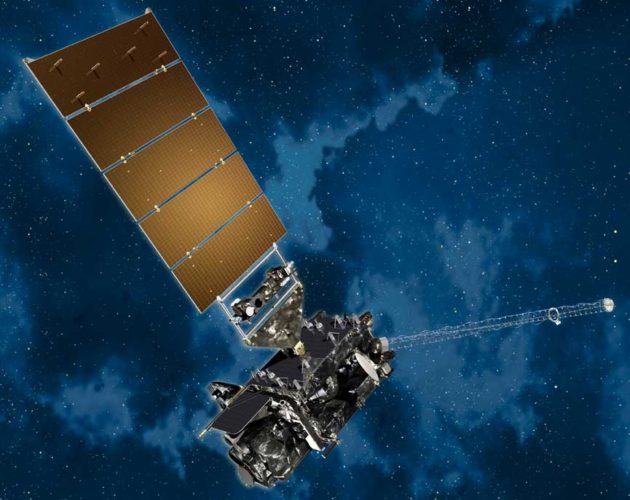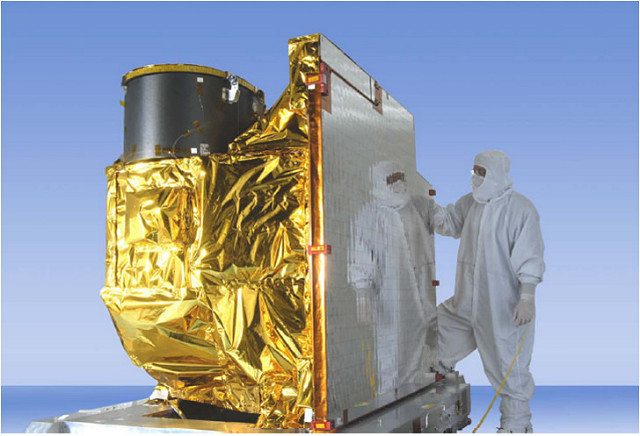NOAA Experts Moving Closer to Resolving Troubles with GOES-17 ABI
Special Stories
31 Jul 2018 8:05 AM
[GOES-R ABI install in Lockheed Martin clean room before launch. From NOAA]
From NOAA
Top officials from NOAA shared new updates on efforts to resolve the technical issues impacting the performance of the GOES-17 Advanced Baseline Imager (ABI), predicting all of the ABI spectral channels will be available for the majority of the day.
The ABI, the primary instrument onboard the satellite, has experienced trouble with its cooling system during the orbital check-out phase of GOES-17's six instruments. The other five instruments are performing normally.
 On ABI, the cooling system of the ABI is not functioning properly, as was discussed in detail last week. Currently the loop heat pipe subsystem, which transfers heat from the ABI electronics to the radiator, is malfunctioning. This is preventing adequate cooling for some of the infrared (IR) channels on the instrument during parts of the day, leading to partial loss of ABI imagery.
Experts have identified four likely causes for the issue and have recommended a set of ground tests to further isolate the specific root cause. Based on these initial findings, NOAA and NASA are evaluating design modifications for the ABI that would fly on future launched satellites like GOES-T and GOES-U. The team of experts have also pinpointed different operating procedures to improve the availability of the IR channels. This will allow the ABI spectral channels to be available for the majority of the day.
On ABI, the cooling system of the ABI is not functioning properly, as was discussed in detail last week. Currently the loop heat pipe subsystem, which transfers heat from the ABI electronics to the radiator, is malfunctioning. This is preventing adequate cooling for some of the infrared (IR) channels on the instrument during parts of the day, leading to partial loss of ABI imagery.
Experts have identified four likely causes for the issue and have recommended a set of ground tests to further isolate the specific root cause. Based on these initial findings, NOAA and NASA are evaluating design modifications for the ABI that would fly on future launched satellites like GOES-T and GOES-U. The team of experts have also pinpointed different operating procedures to improve the availability of the IR channels. This will allow the ABI spectral channels to be available for the majority of the day.
 The availability of the imagery will vary during different times of the year. Initial estimates predict that 13 of the 16 channels will be available the full 24 hours during "cool seasons" (near the summer and winter solstice), with the other three channels available for 20 hours. During "warm seasons" (before the vernal and autumnal equinox), they estimate 10 channels will be available for 24 hours, another 3 will be available for 20 hours, and 3 will be available for approximately 12 hours. Through adjustments in operating procedures and software and algorithm changes, experts hope to revise these estimates as we head into the Fall "warm season" for the satellite.
NOAA’s operational geostationary constellation -- GOES-16, operating as GOES-East, GOES-15, operating as GOES-West and GOES-14, operating as the on-orbit spare -- continues to remain healthy and monitoring weather across the nation each day.
The availability of the imagery will vary during different times of the year. Initial estimates predict that 13 of the 16 channels will be available the full 24 hours during "cool seasons" (near the summer and winter solstice), with the other three channels available for 20 hours. During "warm seasons" (before the vernal and autumnal equinox), they estimate 10 channels will be available for 24 hours, another 3 will be available for 20 hours, and 3 will be available for approximately 12 hours. Through adjustments in operating procedures and software and algorithm changes, experts hope to revise these estimates as we head into the Fall "warm season" for the satellite.
NOAA’s operational geostationary constellation -- GOES-16, operating as GOES-East, GOES-15, operating as GOES-West and GOES-14, operating as the on-orbit spare -- continues to remain healthy and monitoring weather across the nation each day.
 Edited for WeatherNation by Meteorologist Mace Michaels
Edited for WeatherNation by Meteorologist Mace Michaels
 On ABI, the cooling system of the ABI is not functioning properly, as was discussed in detail last week. Currently the loop heat pipe subsystem, which transfers heat from the ABI electronics to the radiator, is malfunctioning. This is preventing adequate cooling for some of the infrared (IR) channels on the instrument during parts of the day, leading to partial loss of ABI imagery.
Experts have identified four likely causes for the issue and have recommended a set of ground tests to further isolate the specific root cause. Based on these initial findings, NOAA and NASA are evaluating design modifications for the ABI that would fly on future launched satellites like GOES-T and GOES-U. The team of experts have also pinpointed different operating procedures to improve the availability of the IR channels. This will allow the ABI spectral channels to be available for the majority of the day.
On ABI, the cooling system of the ABI is not functioning properly, as was discussed in detail last week. Currently the loop heat pipe subsystem, which transfers heat from the ABI electronics to the radiator, is malfunctioning. This is preventing adequate cooling for some of the infrared (IR) channels on the instrument during parts of the day, leading to partial loss of ABI imagery.
Experts have identified four likely causes for the issue and have recommended a set of ground tests to further isolate the specific root cause. Based on these initial findings, NOAA and NASA are evaluating design modifications for the ABI that would fly on future launched satellites like GOES-T and GOES-U. The team of experts have also pinpointed different operating procedures to improve the availability of the IR channels. This will allow the ABI spectral channels to be available for the majority of the day.
 The availability of the imagery will vary during different times of the year. Initial estimates predict that 13 of the 16 channels will be available the full 24 hours during "cool seasons" (near the summer and winter solstice), with the other three channels available for 20 hours. During "warm seasons" (before the vernal and autumnal equinox), they estimate 10 channels will be available for 24 hours, another 3 will be available for 20 hours, and 3 will be available for approximately 12 hours. Through adjustments in operating procedures and software and algorithm changes, experts hope to revise these estimates as we head into the Fall "warm season" for the satellite.
NOAA’s operational geostationary constellation -- GOES-16, operating as GOES-East, GOES-15, operating as GOES-West and GOES-14, operating as the on-orbit spare -- continues to remain healthy and monitoring weather across the nation each day.
The availability of the imagery will vary during different times of the year. Initial estimates predict that 13 of the 16 channels will be available the full 24 hours during "cool seasons" (near the summer and winter solstice), with the other three channels available for 20 hours. During "warm seasons" (before the vernal and autumnal equinox), they estimate 10 channels will be available for 24 hours, another 3 will be available for 20 hours, and 3 will be available for approximately 12 hours. Through adjustments in operating procedures and software and algorithm changes, experts hope to revise these estimates as we head into the Fall "warm season" for the satellite.
NOAA’s operational geostationary constellation -- GOES-16, operating as GOES-East, GOES-15, operating as GOES-West and GOES-14, operating as the on-orbit spare -- continues to remain healthy and monitoring weather across the nation each day.
 Edited for WeatherNation by Meteorologist Mace Michaels
Edited for WeatherNation by Meteorologist Mace MichaelsAll Weather News
More